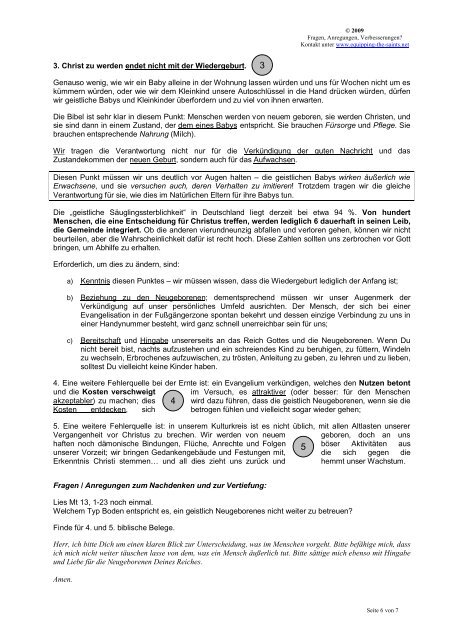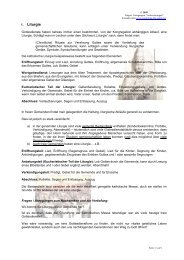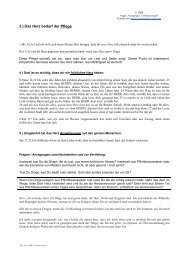Unterlagen zur Predigt - equipping-the-saints.net
Unterlagen zur Predigt - equipping-the-saints.net
Unterlagen zur Predigt - equipping-the-saints.net
- Keine Tags gefunden...
Sie wollen auch ein ePaper? Erhöhen Sie die Reichweite Ihrer Titel.
YUMPU macht aus Druck-PDFs automatisch weboptimierte ePaper, die Google liebt.
Author's personal copy746 J. Wilt et al. / Personality and Individual Differences 48 (2010) 742–746These findings suggest that combinations of SNAP traits may beused to represent specific personality pathologies on a continuum.Although <strong>the</strong> pattern of relationships that emerged betweenSNAP profiles and normal personality traits almost exactly mirroredour expectations, <strong>the</strong> finding that Avoidant characteristicsdid not relate positively to Neuroticism was unexpected given thatthis relationship has been found in previous research (Saulsman &Page, 2004). This finding may be explained by <strong>the</strong> fact that SNAPtraits uniquely defining Avoidant characteristics (Detachment,low Workaholism, low Exhibitionism, low Entitlement, and lowPositive Temperament) do not overlap with SNAP traits reflectingNeuroticism. Thus, it is possible that <strong>the</strong> relationships betweenAPD and Neuroticism observed in past research were due primarilyto <strong>the</strong> overlap between APD and o<strong>the</strong>r PDs. This possibility awaitsfuture research.We also did not predict <strong>the</strong> relationship between Borderlinecharacteristics and peer-reported Extraversion, or those betweenObsessive–Compulsive characteristics and self-reported Agreeablenessand peer-reported Neuroticism. These findings are in line withresearch suggesting that informant-reports of personality pathologymay yield different information than self-reports (Oltmanns &Turkheimer, 2009). Indeed, in <strong>the</strong> current study, <strong>the</strong>re were a numberof results that diverged between self and peer reports. It is importantto exercise caution in interpreting <strong>the</strong>se differences because<strong>the</strong>y were not <strong>the</strong> focus of <strong>the</strong> study and <strong>the</strong> number of reportsdiffered across self and peer reports. However, perhaps <strong>the</strong> mostnotable difference between self and peer results is that Obsessive–Compulsive characteristics were likely to be correlated with only<strong>the</strong> desirable poles of self-reported traits, but with <strong>the</strong> undesirablepoles of peer-reported normal traits. This suggests that individualswith higher levels of Obsessive–Compulsive characteristics maysee <strong>the</strong>mselves more positively than <strong>the</strong>ir peers see <strong>the</strong>m.Findings emerging from <strong>the</strong> FFM profile approach to PDs attest to<strong>the</strong> importance of going beyond investigations of mean level associationsbetween normal personality traits and PDs to examiningwhe<strong>the</strong>r <strong>the</strong> relationships between normal traits explain personalitypathology. This study supports <strong>the</strong> notion that relationships amongnormal traits differ between groups that differ in levels of personalitypathology. MPQ trait correlation matrices for groups with relativelyhigh levels of personality pathology differed from matricesfor individuals with fewer pathological characteristics. Exploratoryanalyses revealed that differences in overall MPQ matrices forBorderline and Schizotypal groups were due in part to divergentrelationships between higher-order MPQ factors.Positive Emotionality and Constraint were highly correlated in<strong>the</strong> high Borderline group and uncorrelated in <strong>the</strong> low Borderlinegroup; this suggests that individuals with elevated Borderlinepathology who are relatively more impulsive and less behaviorallyrestrained also experience relatively lower positive emotions/extraversion. Although this analysis was exploratory, it makesintuitive sense that behavioral control relates to positivity in agroup of individuals whose impairment <strong>the</strong>oretically arises fromdeficits in control (Nigg, Silk, Stavro, & Miller, 2005). Within groupsof individuals with high levels of Schizotypal characteristics, <strong>the</strong>correlation between Positive Emotionality and Negative Emotionalitywas relatively more positive than for low SPD individuals. Takenin <strong>the</strong> context of research showing that individuals with SPDhave a limited capacity to experience both positive and negativeemotions (Waldeck & Miller, 2000), this suggests that <strong>the</strong> tendencyto experience emotion in general (regardless of valence) may berepresented on a continuum in individuals with high levels ofSchizotypal characteristics (i.e., individuals with Schizotypalpathology who experience more positive emotions also experiencemore negative emotions).Limitations of this study suggest avenues for future research.We did not obtain PD diagnoses; thus, future research may fur<strong>the</strong>rvalidate SNAP profile scales by examining whe<strong>the</strong>r profiles aremore strongly related to <strong>the</strong>ir respective PD diagnoses than o<strong>the</strong>rPD diagnoses. The relatively small number of informant-reportslimited <strong>the</strong> precision of estimates obtained using this method;additionally, potential differences between <strong>the</strong> characteristics of<strong>the</strong> participants providing informant reports and those not providinginformant reports may have biased results obtained using thismethod. Future studies will benefit from obtaining informant reportsfor a greater percentage of participants. The overall samplesize of this study yielded relatively small groups of individualswith different levels of personality pathology, which prevented<strong>the</strong> use of formal factor analytic techniques. Future studies couldobtain large samples and explore whe<strong>the</strong>r and how <strong>the</strong> factorstructure of groups of individuals with different levels of personalitypathology differ. Additionally, this study evaluated only four of<strong>the</strong> ten putatively distinct categories of personality pathology; futurestudies should attempt to distinguish o<strong>the</strong>r PDs from eacho<strong>the</strong>r, Axis I disorders, and normal samples. This study convergeswith Morey et al. (2003) to provide evidence for <strong>the</strong> validity ofSNAP profile scales in representing specific personality pathologieson a continuum, and it converges with <strong>the</strong> FFM profile approach toPDs in suggesting that <strong>the</strong> configuration of normal personalitytraits (above and beyond mean levels of traits considered in isolation)is important for understanding manifestations of abnormalpersonality.ReferencesAmerican Psychiatric Association. (2000). Diagnostic and statistical manual of mentaldisorders (4th ed., revised ed.). Washington, DC.Clark, L. A. (1993). Manual for <strong>the</strong> schedule for nonadaptive and adaptivepersonality. Minneapolis: University of Minnesota Press.Clark, L. A. (1999). Dimensional approaches to personality disorder assessment anddiagnosis. In Personality and psychopathology (pp. 219–244). Washington, DC:American Psychiatric Association.Clark, L. A. (2007). Assessment, diagnosis of personality disorder: Perennial issuesand an emerging reconceptualization. Annual Review of Psychology, 58, 227–257.Cohen, J. (1988). Statistical power analysis for <strong>the</strong> behavioral sciences (2nd ed.).Hillsdale, NJ, England: Lawrence Erlbaum Associates, Inc..Costa, P. T., & McCrae, R. R. (1992). NEO PI-R professional manual. Odessa, FL:Psychological Assessment Resources.Goldberg, L. R. (1990). An alternative ‘‘description of personality”: The Big-Fivefactor structure. Journal of Personality and Social Psychology, 59(6), 1216–1229.Harlan, E., & Clark, L. A. (1999). Short forms of <strong>the</strong> schedule for nonadaptive andadaptive personality (SNAP) for self- and collateral ratings: Development,reliability, and validity. Assessment, 6(2), 131–145.Jennrich, J. I. (1970). An asymptotic chi-square test for <strong>the</strong> equality of twocorrelation matrices. Journal of <strong>the</strong> American Statistical Association, 65, 904–912.Lynam, D. R., & Widiger, T. A. (2001). Using <strong>the</strong> five-factor model to represent <strong>the</strong>DSM-IV personality disorders: An expert consensus approach. Journal ofAbnormal Psychology, 110(3), 401–412.Morey, L. C., Gunderson, J., Quigley, B. D., & Lyons, M. (2000). Dimensions andcategories: The ‘‘big five” factors and <strong>the</strong> DSM personality disorders. Assessment,7(3), 203–216.Morey, L. C., Warner, M. B., Shea, M., Gunderson, J. G., Sanislow, C. A., Grilo, C., et al.(2003). The representation of four personality disorders by <strong>the</strong> schedule fornonadaptive and adaptive personality dimensional model of personality.Psychological Assessment, 15(3), 326–332.Nigg, J. T., Silk, K. R., Stavro, G., & Miller, T. (2005). Disinhibition and borderlinepersonality disorder. Development and Psychopathology, 17(4), 1129–1149.Oltmanns, T. F., & Turkheimer, E. (2009). Person perception and personalitypathology. Current Directions in Psychological Science, 18(1), 32–36.Patrick, C. J., Curtin, J. J., & Tellegen, A. (2002). Development and validation of a briefform of <strong>the</strong> Multidimensional Personality Questionnaire. PsychologicalAssessment, 14(2), 150–163.Saucier, G. (1994). Mini-markers: A brief version of Goldberg’s unipolar Big-Fivemarkers. Journal of Personality Assessment, 63(3), 506–516.Saulsman, L. M., & Page, A. C. (2004). The five-factor model and personality disorderempirical literature: A meta-analytic review. Clinical Psychology Review, 23(8),1055–1085.Tellegen, A. (1982). Brief manual for <strong>the</strong> differential personality questionnaire.Minneapolis: University of Minnesota.Waldeck, T. L., & Miller, L. (2000). Social skills deficits in schizotypal personalitydisorder. Psychiatry Research, 93(3), 237–246.Widiger, T. A., & Simonsen, E. (2005). Alternative dimensional models of personalitydisorder: Finding a common ground. Journal of Personality Disorders, 19(2),110–130.





